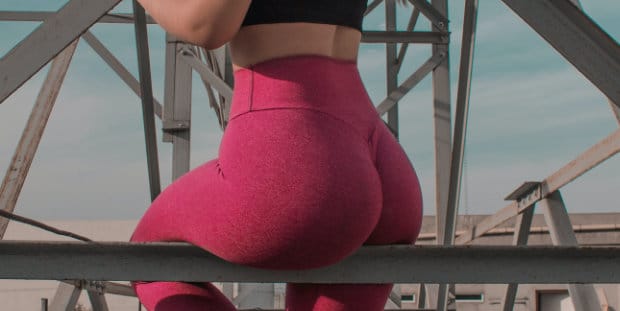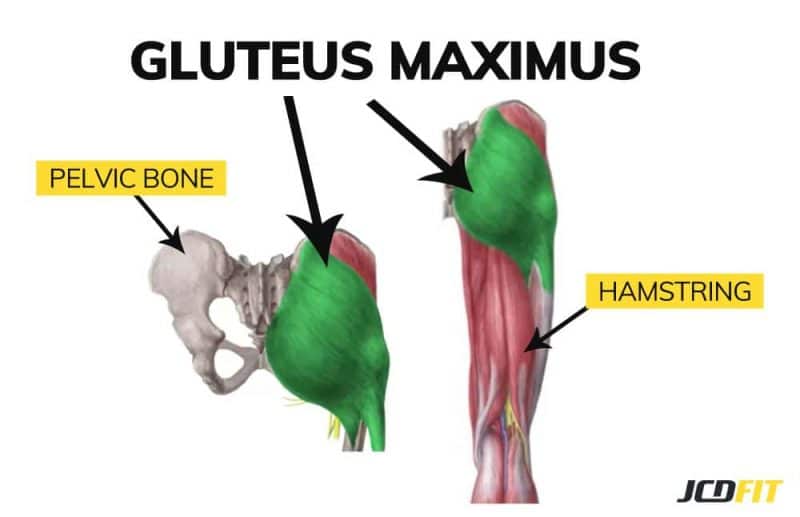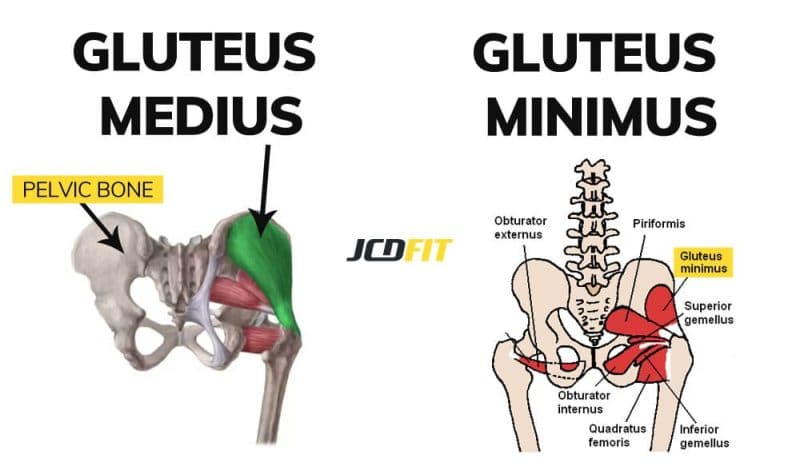Getting your butt to grow can be challenging because there a ton of opinions from influencers on Instagram and TikTok telling you what to do…
But that advice can get confusing.
What type of workouts should you do? Should you use weights, or just work out at home? How often should you work out?
This article is going to break down exactly what you need to do to get a bigger butt
By the time you’re done reading, you’ll know exactly what to do. And I’ll give you a sample workout you can follow to start building your butt asap.

Table of Contents
What Are The Best Butt Building Exercises?
To make your booty grow, you need to focus on exercises that:
- Stress the glute muscles adequately
- Work multiple muscle groups at once (compound exercises)
- Hit your glutes from different angles
Now let’s take a quick look at the glute muscles involved.
Glute Anatomy (In Case You Care)
You have three muscles that make up the gluteal area. Those are the:
- Gluteus maximus
- Gluteus medius
- Gluteus minimus

The Gluteus Maximus is responsible for extending your hip/legs backward. So think about when you’re walking, running up a hill, doing deadlifts, glute bridges, hip thrusts, or the bird dog exercise.
Since the gluteus maximus is the biggest muscle of the glutes, you will want to focus on overloading it when doing your booty workouts.

The Gluteus Medius is responsible for hip abduction, which is raising your leg upward away from your other leg.
Also, it helps you rotate your hips, so think about when you rotate your foot outward from your body. Movements like machine abductions and side lying clams will work your gluteus medius.
The Gluteus Minimus helps the medius muscle in the rotation of the hips.
Now, let’s talk about how you get a bigger butt.
The 7 Best Glute Exercises You Should Be Doing
Those movements are:
- Bodyweight glute bridges (on the floor)
- Barbell glute bridges
- Barbell hip thrusts
- Glute kickbacks
- Romanian deadlifts
- Hyperextensions
- Hip abductions
1. Body Weight Glute Bridges / Hip Thrusts:
The glute bridge and hip thrust are great movements to activate your glutes. They’re also one of the best glute building movements.
How to do these:
- Start with your back on the ground, or on a bench, with your knees bent and feet flat on the ground.
- Press your feet into the ground, lifting your hips off the floor, and think about squeezing your butt as tightly as you can.
- Lower yourself back to the floor and repeat the movement as many times as you wish.
2. Barbell Glute Bridges:
The barbell glute bridge is the next movement you’ll want to master. It allows you to create more tension and load your glutes to grow your butt.
How to do these:
- While sitting on the ground, you’ll want to roll a barbell over your legs to your hips. You’ll want to use a lifting pad because a bare barbell will be painful on your hip bones.
- Once the barbell is over your hips, lay down on the ground, and pull your feet up so your knees are bent.
- Holding onto the barbell, press it down into your hips for stability, and then press your feet into the ground, lifting your hips off the floor. Try to squeeze your butt as tightly as you can.
- Aim to fully extend your hips so there’s a straight line from your knees to your chest.
- Lower yourself back to the floor slowly and repeat the movement as many times as you wish.
3. Barbell Hip Thrusts:
This exercise is a more advanced version of the barbell glute bridge. It allows you to get a better range of motion, creating even more tension to build your butt.
How to do these:
- Set a bench up against a wall, or a stable area (like a rack).
- With your shoulder blades against the bench and legs straight out, you’ll want to roll a barbell over your legs to your hips. Use a lifting pad because a bare barbell will be painful on your hip bones.
- Once the barbell is over your hips, pull your feet up so your knees are bent.
- Holding onto the barbell, press it down into your hips for stability, and then press your feet into the ground, lifting your hips off the floor. Try to squeeze your butt as tightly as you can.
- Aim to fully extend your hips so there’s a straight line from your knees to your chest.
- Lower yourself back to the floor slowly and repeat the movement as many times as you wish.
4. Glute Kickbacks (On A Bench):
Glute kickbacks are a great movement because it allows you to isolate your glutes in ways that hip thrusts and glute bridges won’t allow.
How to do these:
- Set up a bench near a cable machine, with the cable attachment at the lowest position.
- Attach the cable to your foot and then place your other knee on the bench and support your body with your hands.
- With your foot in the cable, extend your leg backward, focusing on contracting your glute and go back as far as you can. Don’t overextend your leg. It only needs to go straight back, and not up above your waist.
- Lower leg back to the starting position and repeat the movement as many times as you wish.
5. Romanian Deadlifts:
The Romanian Deadlift is a fantastic movement to load your glutes because when using a barbell, you can add lots of weight over time. And more weight = more tension, and more tension over time = bigger, stronger glutes.
How to do these:
Ideally, you’ll do these in a rack so you can start on the top position. This is important because we want to to able to focus on lowering the weight slowly and it’s a lot easier to do this when you start standing up as opposed to parallel to the floor or bending over to pick up the barbell (like a traditional deadlift).
- Start with the barbell just below knee height in the rack.
- Bend over to pick up the barbell, hands just slightly outside of your knees, and stand up with the weight. Walk out a few steps from the rack.
- As you lower the weight, start by sticking your butt out, and let the barbell slowly lower down to just below the knees. Try to keep the barbell as close to your thighs as possible.
- When doing it this way, you’ll want to pay attention to the stretch you feel in your hamstrings and glutes and only go as far as you can comfortable.
- Always try to keep your back rigid and let your hips act as a hinge.
- Once you feel a good stretch at the bottom of the movement, forcefully squeeze your glutes and bring the bar back up to the starting position.
- Repeat the movement as many times as you wish with good form.
6. Hyperextensions (with a booty focus):
There are 2 ways to do this movement, so make sure you do the glute-focused version, instead of the hamstring-focused one.
How to do these:
- Make sure the pad is just below your hip bone. This will allow you bend over at the hips and get a good stretch in your glutes.
- Purposefully round your upper back because this will allow you to pull yourself back up with your glutes, instead of your hamstrings.
- Slowly lower yourself down, folding your body over.
- Then come back up and initiate the movement with your glutes. Think of how a glute bridge feels.
- As you get to the top, think about squeezing your glutes as tightly as possible.
- Repeat the movement as many times as you wish.
7. Hip Abductions
This exercise primarily works the outer glutes (glute medius). And you should make sure you’re doing these as a part of your program to get the most glute growth possible. The best way to start is with the bodyweight version lying on your side.
How to do these:
- Lie down on one side with your head supported on your arm.
- With your bottom knee bent, and your top leg straight, , lift your top leg up as far as you can. Make sure you keep your hips firm on the ground and steady.
- Squeeze your glutes at the top and slowly lower back to the starting position.
Here’s an example:
Once this movement is easy for you, move onto the seated abduction machine:
The Big Butt Workout Plan
Now… just knowing what these exercises are won’t help you if you don’t know how to put them into an effective workout.
Below, I’ve outlined a workout program you can do at the gym.
For starters, when you see the 1a, 1b, etc., it indicates a superset. A superset is two movements done back to back with minimal rest in between sets until all sets are completed.
When you see a set of numbers written as 3×12-15, that simply means three sets of 12-15 reps. For more info, check out sets and reps
Grow Your Glutes With These Workouts 👇
1a. Bodyweight Glute Bridge 3×12-15
1b. Modified push-ups 3×5-8
— minimal rest (about 30 seconds) between sets
In this first superset, you’re alternating glute bridges with push-ups. The goal of this superset is to get your glutes warm and activated to ensure you get the most out of the next movement, the barbell hip thrust.
Push-ups are a strength movement for the chest, shoulders, and triceps and it can be done in tandem with glute bridges without negatively impacting lower body performance.
2. Barbell hip thrust 3×8-10
— 2 minutes rest between sets
This is the money movement of the day, and you’ll want to make sure you push yourself hard to use a weight heavy enough that challenges you. So pick a weight that you can do for at least 8 reps and get started.
3a. Barbell Romanian deadlift 3×12-15
3b. 4-point plank 3×30 second holds
— minimal rest (about 30 seconds) between sets
In this superset, you’re alternating barbell Romanian deadlifts and 4-point planks. The goal of this superset is to take advantage of the fatigue the glute bridges and hip thrusts have created in your glutes and stimulate them even more. The Romanian deadlift is a good hip exercise that will work your glutes and hamstrings.
4-point planks will improve your abdominal/core strength without impacting your ability to perform the Romanian deadlifts properly.
4a. Bent over dumbbell rows 3×8-10
4b. Bird-dogs 3×8 per side
— minimal rest (about 30 seconds) between sets
In this superset, you’re alternating bent over dumbbell rows and Bird-dogs. The goal of this superset is to balance out your push-up training from earlier in the session with the rowing movement.
Bird-dogs are a great movement that challenges your core and allows you to get some extra glute work, which should be easy at this point given how much you’ve worked your glutes in this workout already. Note: Focus on really squeezing the glutes at the top of this movement.
5. Side lying glute abductions 3×12-15 per side
— 1 minute rest between sets
Why Weight Training Will Give You A Bigger Butt
Muscles grow when you put them under stress with resistance. So when you lift weights and get stronger over time, the muscles have to grow to adapt with glute workouts. To build a bigger butt, you can do two things:
- Gain weight (add more fat to your butt)
- Grow your butt with weight training
Getting fatter is rather easy, but you cannot guarantee that the fat will be stored on your butt and nowhere else. The chances are that when gain fat on purpose, you will add fat to your stomach, thighs, love handles, and anywhere else you naturally store body fat.
This is where using weight training to make your butt bigger on purpose comes into play.
Some famous social media stars claim you only need bodyweight exercises for a bigger butt, but they won’t give you the best results as fast as you want them.
Specifically, using resistance training movements that target the butt muscles is exactly what you want to do. Deadlifts, hip thrusts, hyperextension (back extension), squats, and glute bridges are the ideal butt exercises, for a bigger butt.
Focus On Compound Movements And Life More Over Time
Muscle growth comes from progressive overload.
Progressive overload is a fundamental principle that means you are continually adding resistance to your lifts over time. This will continuously challenge your muscles, and force them to get stronger and grow as your body repairs itself.
It’s easy to get caught up in just going through the motions like bodyweight squats, hip thrusts, glute bridges, and clamshells, but if you don’t make the exercises more challenging over time, your butt won’t grow as much as it could.
So when building a bigger butt, you’ll want to make sure that you’re getting stronger on the exercises you are doing.
The best way to make this happen is by:
- Logging and tracking all of your workouts
- Starting with a weight that is easily managed so you can progress over time
- Ensuring you take time off of the gym to allow for proper recovery
Why Are Strong Glutes Important?

They’re functional. Stronger glutes lends to a stronger lower body. And a strong lower body allows you to move in ways you’d like outside of working out.
A stronger butt can help you maintain better posture.
And a stronger butt is often going to lead to a bigger butt. The more you focus on lifting and strengthening your glutes, the bigger your butt will grow.
How To Make Your Butt Bigger And More Toned

Here’s how to get a bigger booty in 3 steps, and they’re all equally important.
Step #1: Train Your Butt 2-3 Times Per Week In The Gym (Or At Home)
Since you already know which movements are best for building your backside, you’ll want to make sure you do those movements 2-3 times per week. I prefer full body training because it will allow you to hit your glutes and hamstrings throughout the week with different movements and various angles. Also, if you want to do some extra booty work, you can use my resistance band glute workout at home.
Step #2: Eat Enough Protein And Calories To Make Your Butt Grow
Making your butt grow will take time. You won’t wake up in a few days with a bigger butt after following the workout I’ve laid out for you.
But if you keep it up, you will see growth and positive changes within the next eight weeks.
The Golden Diet Rule: A Caloric Surplus
If you want your butt to grow, it needs fuel. The food you eat is what gives your body the energy to build more muscle from your hard workouts.
To create your caloric surplus, I recommend that you do it ONLY on the days you workout. So if you are working out three days per week, you would ideally be eating 100-300 calories above your maintenance intake.
To get an idea of why I recommend a surplus on training days only, you can read my caloric surplus
Here’s an image I made to illustrate my point quickly:

“But how do you know how much to eat?”
Since I get this question a lot, I created a simple-to-use calorie intake calculator to to determine a good starting point.
Step #3: Rest And Recover Properly
The days you’re not working out are when your body repairs itself, and this is where progress occurs.
If you never give your body time to heal and recover, you won’t see the results you want.
The most important part of recovery is making sure you get enough sleep.
Sleep is the most underrated and overlooked part of the recovery process.
It’s easy to search for all the supplements, food choices, and workout plans that provide the best recovery.
But no diet changes or supplements can hold a candle to how restorative proper sleep can be.
So make sure getting enough restful, uninterrupted sleep (around 7-9 hours per night) a huge priority.
Above all else, your recovery comes down to the following factors:
- Getting enough quality sleep
- Eating well enough to allow recovery to happen
- Taking 2-4 deliberate days off from the gym (cardio too) per week
- Participating in relaxing activities (massage, walking, time out with friends, etc.)
Training is the active part of the muscle building process and recovery is the passive part. They’re both equally important, so don’t skimp on taking time to recover from hard workouts.
To be clear, this means taking complete rest days off from the gym. You can still be active, but rest days shouldn’t involve any exercise that challenges you intensively.
How To Track Your Butt Growth Progress

Tracking progress should be so easy that you have no reason to skip out on it.
Tracking progress should be so easy that you have no reason to skip out on it.
There are four metrics you should be using to track progress correctly.
Those are:
- Body weight averages
- Measurements
- Regular progress photos
- Putting on an old pair of pants
When tracking your bodyweight, it’s important to remember that it will fluctuate on a daily basis.
By taking a weekly average you’ll get an accurate picture of what’s going on with your weight.
Many times we get on the scale a few times per month at random times during the day and our weight can be up or down due to many factors.
And depending on our mood, it can make or break our day.
Make sure you stick to the proper conditions for tracking your bodyweight:
- Weigh yourself in the morning after going to the bathroom and before eating/drinking anything
- Always do it in your underwear
- Keep a log of each day it to average at the end of the week
NOTE: if weighing yourself everyday freaks you out, then you don’t have to do it. Just realize that weighing yourself once per week may not be accurate given how much our weight can fluctuate from day to day.
Criteria for tracking your measurements:
The next metric and probably the most important variable to track are your measurements.
For all of my clients, I have them measure their waist in three places.
- 2 inches above the navel
- At the navel
- 2 inches below the navel
- Widest part of the hips
But since we store the most fat in our stomach, we’ll notice the most significant changes in this area over time.
However, this guide is about building a bigger butt.
So you’ll want to add your hip measurements to make sure your butt is growing.
In general, you should see your booty steadily improving over the 6-8 weeks you do this program.
Tracking waist measurements will also help you see if you’re gaining unwanted weight during your pursuit of a bigger butt.
Progress Pictures
Take a look at Instagram and there are TONS of booty photos.
So to track your journey, I highly recommend you take some selfies once every few weeks. These photos should be under the same conditions when you weigh/measure yourself.
You might be surprised when you look back at the end of 8 weeks to a sizable difference in your booty gains.
Trying On Your Old Clothes
These booty workouts will tend to make your clothes sit differently on your body. So put on a pair of pants and see is there’s a change. You can do this every few weeks, just like the progress pictures.
And when you notice the seat of your pants feeling tighter while the waist still fits properly, you’re making booty gains!
Are You Ready To Build Your Glutes?
Download my 8-Week Glute Training Program. Click the button below to get a workout sent straight to your inbox.
